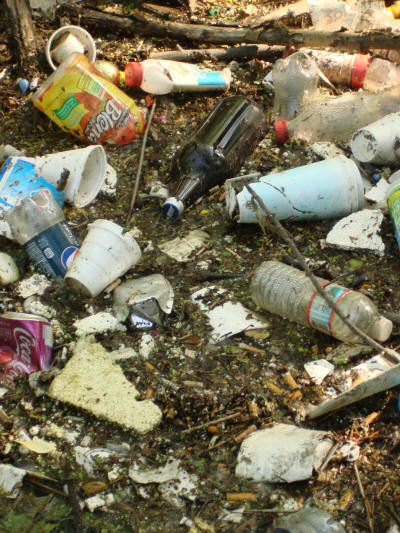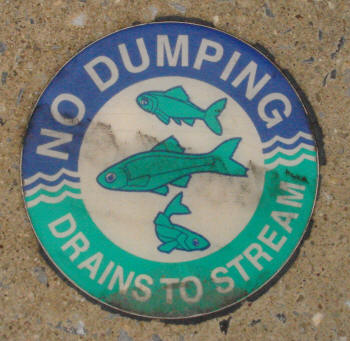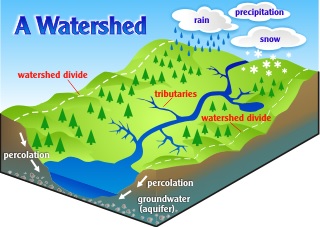Like riverkeepers everywhere, the Quittapahilla Watershed Association seeks to improve the water quality of our watershed by first being clear about the main problems & issues it faces. Powell's 2006 study offers a thorough and compelling analysis of those problems & issues and a clear path forward for addressing them.
On this page we build on Powell's discussion to briefly outline what we see as the major problems & issues our watershed confronts today and into the foreseeable future; the most viable strategies for mitigating them; and resources one might tap into for learning more. The discussion here is by no means comprehensive, but we hope it is provocative and useful.
We focus on five main issues:
1. Urban Stormwater Contamination
3. Municipal Separate Storm Sewer System Issues (MS4)
4. Public Indifference & Apathy
5. Inadequate & Inapt Laws & Regulations
In what remains of this page we briefly address each of these spheres and suggest resources for learning more.
URBAN STORMWATER CONTAMINATION
 The photo at
right, a fairly typical
scene along Quittie
Creek, only
begins to suggest the
dizzying variety of
human-produced toxic
substances that make
their way into the
Quittapahilla mainstem
as a result of urban
runoff, mainly from the
City of Lebanon.
The photo at
right, a fairly typical
scene along Quittie
Creek, only
begins to suggest the
dizzying variety of
human-produced toxic
substances that make
their way into the
Quittapahilla mainstem
as a result of urban
runoff, mainly from the
City of Lebanon.
Every street, driveway, and parking lot in this city of 26,000 drains directly into the Quittie. The result is not only systematic contamination by stuff that floats and that you can see, like Styrofoam, wrappers, bags, bottles, cigarette butts (clustered at lower right in the photo), juice boxes, lighters, shoes, toys, and endless other pieces of petroleum-based plastic -- what the Quittapahilla Creek Garbage Museum features in its exhibitions and calls "rogue garbage" (trash that escapes the conventional waste stream).
Uncounted toxic substances invisible to the naked eye also wash into the creek from city streets, driveways & parking lots: oil, grease, power steering fluid, brake fluid, and other toxic residue from cars & trucks; drugs from discarded pharmaceuticals; herbicides, pesticides & fertilizers from lawns & gardens; detergents from people washing their cars; pet waste; road salts; the spills that the local newspaper reports in the Police Log almost every day (under the heading "spill control," and usually without naming the contaminant). Car tires sit at the bottom of the creek slowly decomposing, as does electronic waste, iron, and other metals and toxic substances.
We don't really know the extent of such contamination, but we do know it's huge, ongoing, and systemic. No scientific studies on urban runoff into the Quittie have ever been conducted, and Lebanon County's wastewater treatment plants do not test or treat for the vast majority of human-produced toxins. We also know that the Chesapeake Bay is being choked by the constant infusion of such contaminants from hundreds of creeks like the Quittie.
Do viable solutions exist? The city could sweep its streets more often, and make a special point to sweep at certain key seasonal moments -- especially right after the snowbanks melt but before the first big spring rainstorm. Municipalities and new developments could install, clean & maintain filters on the storm drains, and conduct public education & outreach campaigns to encourage residents to clean the small sections of street in front of their homes & businesses. Corporations could be compelled to pay a tax on each of the zillions of pieces of throwaway plastic they produce, or to offer redemptions for returned wrappers & packaging, though passage of such a tax plan in PA is highly unlikely. Plastic bags could be outlawed altogether, as in California -- though such a ban would likely never become law, given the immense power of industry lobbies. If past experience is any guide, market-based solutions can at best tinker around the edges of the problem.
In light of tight municipal budgets, the crushing power of industry lobbies, and the severe limitations of market-based initiatives, the only viable solution that we can see -- one that would also be virtually cost-free -- would be for thousands of ordinary people throughout the watershed to become more mindful of their trash disposal habits, routinely clean up the urban debris that accumulates in front of their homes & businesses, and, over time, integrate into their consciousness an urban land ethic à la Aldo Leopold.
In sum, the most viable solution to the problem of contaminated urban runoff in the Quittie is, in our view, working to develop & nurture greater mindfulness among a critical mass of the citizenry, especially in Lebanon City. We need to do more to educate people -- a requisite first step in changing their behavior.
RESOURCES:
• Quittapahilla Creek Garbage Museum. Locally, the organization that has done the most to document the stunning variety of plastic & other types of trash in the Quittapahilla watershed is the Quittapahilla Creek Garbage Museum, winner of the 2017 Governor's Award for Environmental Excellence. The Museum is currently being rebuilt at 189 School House Lane in South Annville Township, and hopes to reopen again soon. See the QCGM Facebook page, at https://www.facebook.com/AnnvillePA.
• Environmental Protection Agency. The federal Environmental Protection Agency has a very useful set of resources on watersheds and non-point source (NPS) pollution, at https://www.epa.gov/nps
• Wikipedia. The Wikipedia page on Urban Runoff offers an excellent overview of the problem: https://en.wikipedia.org/wiki/Urban_runoff
• Natural Resources Defense Council. A very useful discussion, with further references, can be found on the NRDC website, at http://www.nrdc.org/water/pollution/storm/chap3.asp
• "Want to Help Reduce Water Pollution? Here's How." A helpful article by John Hawthorne, at https://moboxmarine.com/blog/reduce-water-pollution.
Content is forthcoming.
MUNICIPAL SEPARATE STORMWATER SEWER SYSTEM ISSUES (MS4)
Content is forthcoming.
PUBLIC INDIFFERENCE & APATHY
 If you stop &
ask an average US
citizen what
watershed they live in,
chances are very good
that they don't know.
Indeed, most Americans
don't understand the
concept of a watershed
(see "Watersheds — An
Important But Often
'Impenetrable' Idea" by
Kevin J. Coyle,
President of the
National Environmental
Education & Training
Foundation, Nov. 1999,
at
https://p2infohouse.org/ref/17/16590.pdf
If you stop &
ask an average US
citizen what
watershed they live in,
chances are very good
that they don't know.
Indeed, most Americans
don't understand the
concept of a watershed
(see "Watersheds — An
Important But Often
'Impenetrable' Idea" by
Kevin J. Coyle,
President of the
National Environmental
Education & Training
Foundation, Nov. 1999,
at
https://p2infohouse.org/ref/17/16590.pdf
This widespread public indifference, apathy, and ignorance comprises one of the most important and, to borrow from Kevin J. Coyle, "impenetrable" obstacles to improving the water quality in the Quittapahilla watershed specifically, and all US watersheds generally.
How do we get more people to pay attention to such things? How do we get watershed issues on the public radar screen? How do we encourage ordinary people to care?
All we can do is try. Education must start with young people -- the younger, the better. Kindergartners ought to be learning about watersheds -- their brains are certainly mature enough to understand the concept. Public schools ought to be integrating learning units on watersheds and the rudiments of ecological science into K-12 curricula: the difference between a river and a lake, for instance; the hydrological cycle; food chains; the mutual dependency of organisms; how ocean currents work; the world's five Great Oceanic Garbage Patches and how they got there -- basic information that all citizens should know.
MS4 has a "public education & outreach" component that ought to be taken more seriously by municipalities. The Lebanon County Clean Water Alliance, as part of its MS4 initiatives, has sponsored a number of advertisement campaigns in the local newspaper (see LCCWA on this website). But these seem more intended to gain the necessary credits for municipalities' MS4 programs than as serious & sustained efforts to educate the public about watershed issues. Few kids read newspapers, and the sad fact is, not many adults do either.
 Penn State
Extension's
"Watershed Protection
and Restoration" page
is a good
start, but need to be
supplemented by more
local initiatives.
From 2011 to 2017, the Quittapahilla Creek
Garbage Museum in
Annville hosted field
trips by local schools,
to help kids learn that
"what's in the street
ends up in the creek."
But such initiatives
only begin to touch a tiny
percentage of the
school-age population.
Little plaques on
stormwater drains that
read "NO DUMPING •
DRAINS TO STREAM,"
like the one at right
along Main Street in
Annville, also help
raise public awareness,
though there aren't
enough of them -- every
storm drain in the
county ought to carry
this little emblem or
one like it, but right
now only a tiny fraction
do.
Penn State
Extension's
"Watershed Protection
and Restoration" page
is a good
start, but need to be
supplemented by more
local initiatives.
From 2011 to 2017, the Quittapahilla Creek
Garbage Museum in
Annville hosted field
trips by local schools,
to help kids learn that
"what's in the street
ends up in the creek."
But such initiatives
only begin to touch a tiny
percentage of the
school-age population.
Little plaques on
stormwater drains that
read "NO DUMPING •
DRAINS TO STREAM,"
like the one at right
along Main Street in
Annville, also help
raise public awareness,
though there aren't
enough of them -- every
storm drain in the
county ought to carry
this little emblem or
one like it, but right
now only a tiny fraction
do.
Public signage, like "You are in the Quittapahilla Watershed" and "Garbage in the Street = Garbage in the Chesapeake Bay" ought to be peppered throughout the City of Lebanon. These needn't be big or obtrusive -- the size of a "No Parking" sign would do. A half-dozen or so large billboards, especially around the City of Lebanon and financed through grants, ought to feature watershed-related content.
There is so much that could be done. We need to be creative, aggressive, and relentless in working to raise public consciousness about these issues.
RESOURCES:
 • The
Environmental Protection
Agency features
a useful set of
resources on its
website, at
http://water.epa.gov/learn/training/wacademy/toprelated.cfm
• The
Environmental Protection
Agency features
a useful set of
resources on its
website, at
http://water.epa.gov/learn/training/wacademy/toprelated.cfm
• The Pennsylvania Department of Conservation & Natural Resources (PA-DCNR) also features a useful set of watershed education materials, at https://www.dcnr.pa.gov/Education/WaterEducation/Pages/default.aspx
• The Susquehanna Watershed Education Program (SWEP), sponsored by the Chesapeake Bay Foundation, offers a series of educational day programs for young people; as described in their "Program Overview," "These hands-on adventures introduce participants to the complex relationship between land use and aquatic habitats, local water quality, and the health of the Bay. They promote a deeper understanding of environmental issues, and motivate future leaders to take action to improve the water in their communities and beyond." See https://www.cbf.org/about-cbf/our-mission/educate/index.html
• The Lancaster County Conservation District offers a wide range of useful educational resources on watersheds -- see in particular https://lancasterwatersheds.org/educational-tools/ and https://lancasterwatersheds.org/useful-links/
• The
"Water Quality" tab on
the website of the
Little Falls Watershed
Alliance in Maryland
offers an attractive and
reader-friendly
presentation of their
monitoring program, with
pages on "Bacteria,"
"Macroinvertebrates,"
"Salt Testing," "Water
Quality Monitoring," and
"Water Quality Reports"
-- visit
https://www.lfwa.org/
INADEQUATE LAWS & REGULATIONS
Content forthcoming.